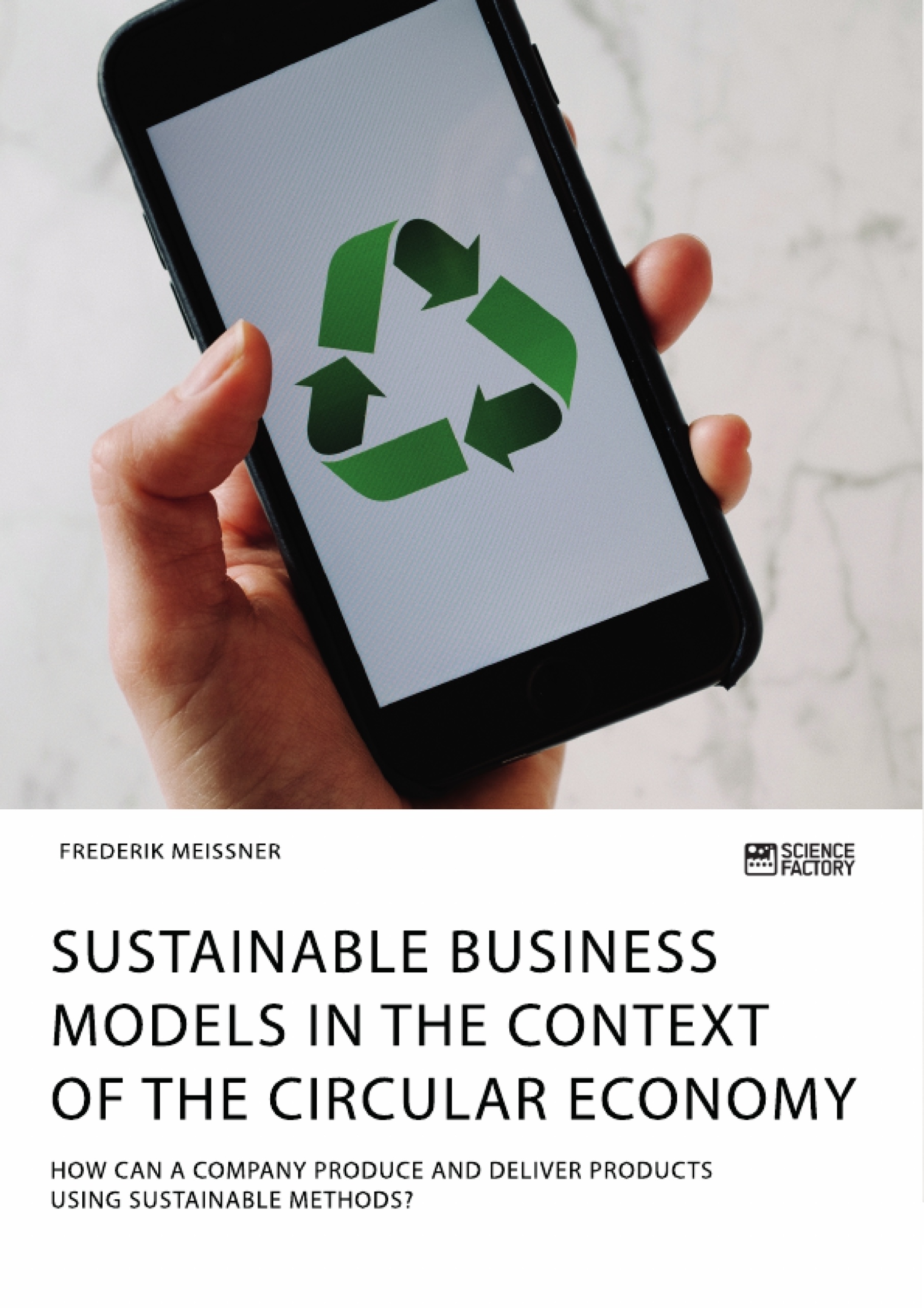
Sustainable business models in the context of the circular economy. How can a company produce and deliver products using sustainable methods?
Fachbuch, 2020
44 Seiten
Leseprobe
Inhaltsverzeichnis (Table of Contents)
- Abstract
- 1 Introduction
- 2 Theoretical Foundation
- 2.1 The Circular Economy
- 2.2 Osterwalder's Business Model Canvas
- 3 Cases
- 3.1 A Modular Mobile Phone
- 3.2 A Refurbishment Service for Mobile Phones
- 4 Analysis
- 4.1 Methodology
- 4.2 The Business Model of Fairphone
- 4.3 The Business Model of Mazuma Mobile
- 5 Discussion
- 5.1 Fairphone and Mazuma Mobile in the Context of the Circular Economy
- 5.2 Implications for Theory and Practice
- 5.3 Limitations
- 6 Conclusion
Zielsetzung und Themenschwerpunkte (Objectives and Key Themes)
This bachelor thesis examines the implementation of sustainable business models in the mobile phone industry, specifically focusing on Fairphone and Mazuma Mobile. The study analyzes these companies' efforts to create and deliver products using sustainable methods within the framework of the Circular Economy. The research aims to understand how these businesses contribute to a circular economy and what challenges they face in their sustainability endeavors.
- The application of the Circular Economy principles in the mobile phone industry
- The assessment of two specific sustainable business models: Fairphone and Mazuma Mobile
- The analysis of the business model of Fairphone, a company producing modular, long-lasting, and transparent smartphones
- The evaluation of Mazuma Mobile's refurbishment service, which focuses on providing second-hand mobile phones and facilitating device recycling
- The examination of the challenges and opportunities for sustainable business models in the mobile phone industry.
Zusammenfassung der Kapitel (Chapter Summaries)
Chapter 1 provides an introduction to the topic, highlighting the importance of sustainable business models in the context of the circular economy. The chapter also outlines the research questions and the thesis' structure.
Chapter 2 lays the theoretical foundation by discussing the concept of the Circular Economy and its relevance to sustainable business practices. The chapter further introduces Osterwalder's Business Model Canvas as a framework for analyzing business models and their sustainability.
Chapter 3 presents the two case studies: Fairphone and Mazuma Mobile. It describes their respective business models and their approaches to sustainable product design and service provision.
Chapter 4 analyzes the business models of Fairphone and Mazuma Mobile using Osterwalder's Business Model Canvas. It explores the key elements of each business model, including value propositions, customer relationships, revenue streams, and key activities.
Chapter 5 discusses the findings of the analysis and evaluates the contribution of Fairphone and Mazuma Mobile to the Circular Economy. It highlights the strengths and limitations of each company's approach and discusses the implications for future sustainable business practices.
Schlüsselwörter (Keywords)
The thesis focuses on the intersection of sustainable business models and the Circular Economy, specifically examining the mobile phone industry. Key concepts include circular economy, sustainable business model, modular design, refurbishment, recycling, Fairphone, Mazuma Mobile, Osterwalder's Business Model Canvas, and value chain transparency.
Details
- Titel
- Sustainable business models in the context of the circular economy. How can a company produce and deliver products using sustainable methods?
- Autor
- Frederik Meissner (Autor:in)
- Erscheinungsjahr
- 2020
- Seiten
- 44
- Katalognummer
- V507908
- ISBN (eBook)
- 9783964871770
- ISBN (Buch)
- 9783964871787
- Sprache
- Englisch
- Schlagworte
- Business Model Canvas Technical Cycle Nine Building Blocks Value Creation Value Capturing
- Produktsicherheit
- GRIN Publishing GmbH
- Preis (Ebook)
- US$ 20,99
- Preis (Book)
- US$ 29,99
- Arbeit zitieren
- Frederik Meissner (Autor:in), 2020, Sustainable business models in the context of the circular economy. How can a company produce and deliver products using sustainable methods?, München, Page::Imprint:: GRINVerlagOHG, https://www.diplomarbeiten24.de/document/507908
- Autor werden
- Ihre Optionen
- Vertriebskanäle
- Premium Services
- Autorenprofil
- Textarten und Formate
- Services für Verlage, Hochschulen, Unternehmen

- © GRIN Publishing GmbH.
- Alle Inhalte urheberrechtlich geschützt. Kopieren und verbreiten untersagt.
- info@grin.com
- AGB
- Open Publishing
Der GRIN Verlag hat sich seit 1998 auf die Veröffentlichung akademischer eBooks und Bücher spezialisiert. Der GRIN Verlag steht damit als erstes Unternehmen für User Generated Quality Content. Die Verlagsseiten GRIN.com, Hausarbeiten.de und Diplomarbeiten24 bieten für Hochschullehrer, Absolventen und Studenten die ideale Plattform, wissenschaftliche Texte wie Hausarbeiten, Referate, Bachelorarbeiten, Masterarbeiten, Diplomarbeiten, Dissertationen und wissenschaftliche Aufsätze einem breiten Publikum zu präsentieren.
Kostenfreie Veröffentlichung: Hausarbeit, Bachelorarbeit, Diplomarbeit, Dissertation, Masterarbeit, Interpretation oder Referat jetzt veröffentlichen!
- GRIN Verlag GmbH
-
- Nymphenburger Str. 86
- 80636
- Munich, Deutschland
- +49 89-550559-0
- +49 89-550559-10
- info@grin.com
-









